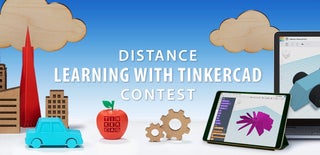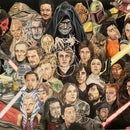Introduction: How to Design a Print-in-Place 3D Ball Bearing (with Pictures)
This simple and easy lesson will show you step-by-step how to design a print-in-place ball bearing in Tinkercad! This is a great example of how to print a movable object. Ball bearings are used a wide variety of products: from a fidget spinner to a computer fan, ball bearings are in every day life.
This tutorial will show you how to design a ball bearing that you can show in the classroom. The object we are creating is for educational purposes, that is to demonstrate how a ball bearing works.
I had my students follow these instructions and then make modifications to their ball bearings!
Step 1: Sign in to Tinkercad and Create a New Design
If you don't already have a Tinkercad account, create an account. This is a powerful, yet easy-to-use tool that any age can use to create 3D models.
Once you are signed into your Tinkercad account, create a new design. Then, in the upper left corner of the screen, rename your design "Ball Bearing"
Step 2: Drag and Drop a Torus Shape Into the Workplane
First, we are going to create the base for our ball bearing. For this, you will need to drag and drop a Torus Shape onto the Workplane. Change the dimensions to 100 mm x 100 mm and 25 mm tall.
Next, change the object from Solid to Hole. This will make the next step easier for us!
Step 3: Drag and Drop a Sphere Onto the Workplane
Drag and drop a Sphere onto the Workplane and align it so that it is inside the Torus shape we made. Then drag another Sphere onto the Workplane and align it on the other side of the Torus. Right now, your ball bearing should look like a donut with two sprinkles.
Step 4: Duplicate the Two Spheres
Drag 6 more Spheres onto the Workplane. Align them so that they look like a circle of Spheres. Try to space them evenly apart, but don't worry if it's not perfect!
For the last part of this step, highlight and group the Spheres together, using the Group button. Move the Spheres 2.00 mm off the Workplane so that they are "floating." When print the object, we need to be sure that the Spheres do not stick to our base!
Step 5: Align the Spheres and Torus Objects
To align the Spheres and Torus objects, select the group of Spheres and the Torus object. Click on the Align button towards the upper right corner of the Tinkercad toolbar. Align the objects so that the Spheres are inside the Torus object. Please be sure that the Spheres are 2.00 mm in the air from the Workplane while the Torus object is 0.00 mm off the Workplane.
Step 6: Drag and Drop a Cylinder Onto the Workplane
Drag and drop a Cylinder object onto the Workplane. Resize it so that the Cylinder fits around the Torus object. My dimensions are 96 mm x 96 mm x 26 mm.
Next, turn the Cylinder from Solid to a Hole object. Align the Torus and Spheres with the Cylinder.
Step 7: Copy and Paste the Cylinder Object
Copy and paste the Cylinder object. Resize it so that its edges align with the center of the Spheres. Drag the height up so that it is taller than the rest of the objects--it doesn't matter what height, just so that it can be easily maneuvered later. My dimensions are 65 mm x 65 mm x 40 mm.
Next, copy and paste the Cylinder object one more time. Resize and align this so that it is just bigger than the previous one. Mine is 75 mm x 75 mm x 35 mm. You will want to align all the objects so that they are centered.
Step 8: Make It Solid!
First, we are going to take the outer Cylinder and make it solid. Move this Cylinder away from the other objects. Next, grab the next largest hole Cylinder and move it inside the outer Cylinder that you just moved. Group these two objects together.
Move the Spheres out of the remaining objects. With the remaining Cylinder and the Torus, change the height of the Cylinder to be 25 mm.
Next, move the ring looking Cylinder and align it with the Torus and Cylinder. Lastly, group these objects together.
Step 9: Combine the Objects
Align the Spheres and the Cylinder objects. Next, move your view around and ensure that the Spheres are not touching any of the walls. I resized my Spheres so that they fit just snug enough so that there is a gap between the Cylinder object and the Spheres. You can turn your Cylinder object into a hole so that you can view how far apart your Spheres are from the Cylinder wall.
Step 10: Supports?
You can either design supports for the Spheres or let your slicer program do the work for you!
If you want to design them, drag and drop a new Cylinder object onto the Workplane. Next, drag and drop a hole Cylinder onto the Workplane. I resized the solid Cylinder to 71 mm x 71 mm and the hole Cylinder to 68 mm x 68 mm.
Align the two Cylinders and then group them.
Align the support Cylinders with the main object. Be sure that the support Cylinder ring is not touching the main object.
Lastly, change the height of the support Cylinder so that the Spheres of the main object are resting on it.
Add a hole in the middle of your object if you want! All you have to do is drag and drop a hole Cylinder onto the Workplane, resize it (be sure that it does not touch the Spheres), and align the objects.
Step 11: Ready to Print!
Group all your objects together and then export them as an .stl or .obj file.
Open your favorite slicer program and import the .stl file. If you did not make supports in the previous step, be sure that you have supports!
If you made supports, you do not need to generate them.
My settings are: infill 25%, layer height 0.2 mm, no supports, and a brim.
You can resize this object to whatever you would like! You may have to change the line width so that the supports to do not stick to the Spheres; remember, you want the Spheres to be able to move.
Step 12: Final Product!
Congratulations! You have 3D printed a ball bearing of YOUR design! This is a great item to show how a ball bearing works; it's also a great fidget spinner toy!
I hope you enjoyed this tutorial:)
Step 13: Student Examples
Here are some student examples. Again, I had my students follow along to these instructions and create their own designs. Many chose to add extra features.
As well as teaching my students how a ball bearing works, this is a great way for students to make their own fidget spinners!
Here are some links to my student's work whose projects are public on Tinkercad:

Participated in the
Distance Learning with Tinkercad Contest











